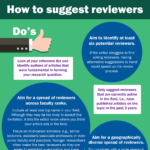Journals often struggle to find willing reviewers, which can lengthen the publication process. To combat this, you may be requested to suggest reviewers at the submission stage. In the following infographic, we provide some tips on identifying suitable reviewers. The infographic contains the following text: Do’s Aim to identify at least six potential reviewers. […]
Discussing your study’s limitations
Why include a limitations section? Including a section on the limitations of your findings will demonstrate command over your research. A reviewer may look negatively upon your study if they spot a limitation that you failed to acknowledge. If you discuss each limitation in the context of future research—i.e., suggest ways to improve the validity […]
Author or contributor? The A to Z of authorship
The average number of authors on scientific articles has increased 5-fold over the last 100 years, from one author per paper in 1913 to more than five authors per paper in 2013 [1], and recent times have seen the rise of hyperauthorship, with one paper listing 5,154 authors [2]. This development has resulted in an […]
How to choose a journal
With an estimated 30,000 active scientific journals, each with their own specific requirements, it can be difficult to know where to send your article. Here, we present a short video blog with some tips on choosing the right journal. In summary: 1. Look at your reference list Identify the journal titles of: articles that were […]
How to reference (Part 1)
There is an abundance of resources out there to help with referencing, many of which focus on the technicalities, such as the best style of referencing to use or the best software. However, there is a lack of guidance on how to interweave references into the narrative, which articles to include or exclude, whether to […]





